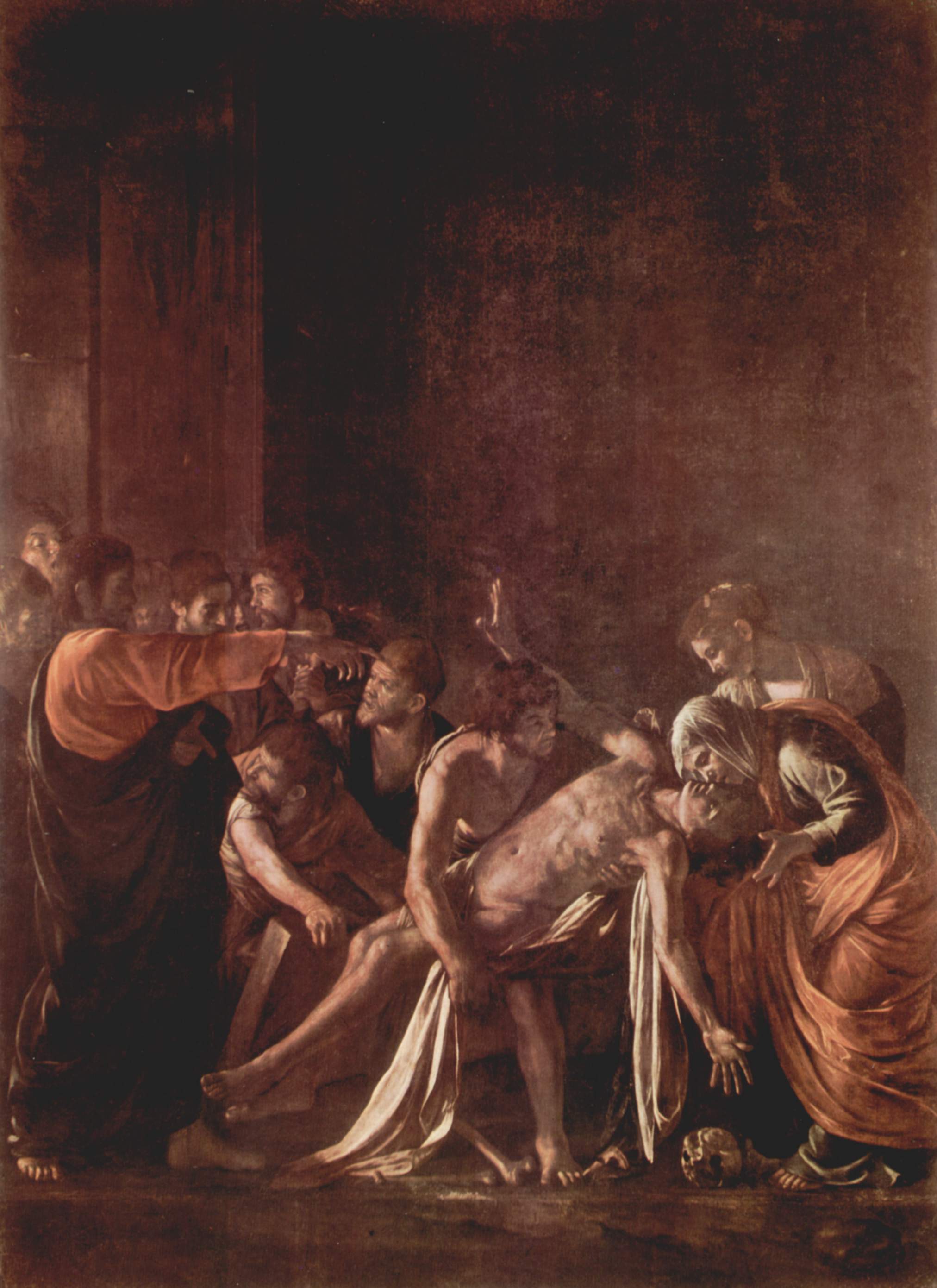- The Raising of Lazarus (Caravaggio)
title=The Raising of Lazarus
artist=Caravaggio
year=c. 1609
type=Oil on canvas
height=380
width=275
museum=Museo Regionale, Messina"The Raising of Lazarus", c. 1609, in the
Museo Regionale ,Messina , is a painting by the Italian artistCaravaggio (1571 -1610 ).In August 1608 Caravaggio fled from
Malta , where he had been imprisoned for an unknown crime, and took refuge in Sicily with his friend, the artistMario Minniti . Through Minniti's intercession he procured a number of important concessions, including this for the church of the Padri Crociferi in Messina, where it was presented by the wealthy Genoese merchant Giovanni Battista de' Lazzari on10 June 1609 . The fee was a thousand scudi, more than double any Caravaggio had received previously.The
Gospel of St John tells howLazarus , the brother of Martha and Mary, fell sick, died, was buried and then miraculously raised from the dead by Christ. As in several paintings from this period of Caravaggio's career, the scene is set against blank walls that overwhelm the frieze of human actors. The interaction of the relief of figures caught in corporate effort and emotion, with a large void above, is quite different from the closely focussed individualised dramas of his early and middle periods. As is usual with Caravaggio, light becomes an important element in the drama, picking out crucial details such as Lazarus's hands - one lax and open to receive, the other reaching towards Christ - and the wonder-struck faces of the onlookers.The old story that Caravaggio had a freshly-buried body exhumed for this painting is "probably apocryphal, but not beyond the bounds of possibility" (John Gash, see below). Some of the figures were said to be modelled on members of the community, but Caravaggio has also relied on his memory - the whole design is based on an engraving after Giulio Romano and his Jesus is a reversed image of the Christ who called Matthew to join him in "The Calling of Saint Matthew". The painting is in poor condition and much restored, and it's possible that some passages are the work of assistants.
Lazarus, the brother of Martha and Mary, was the patron saint of Giovanni Battista de' Lazzari, to whom Caravaggio was contracted to paint an altarpiece in the church of the Padri Crociferi. The Gospel of St John tells how Lazarus fell sick, died, was buried and then miraculously raised from the dead by Christ.
Most of Caravaggio's religious subjects emphasize sadness, suffering and death. In 1609 he dealt with the triumph of life and in doing so created the most visionary picture of his career. Once again, the scene is set against blank walls that overwhelm the actors, who once more are laid out like figures on a frieze. Some of them, says Francesco Susinno, an 18th century biographer of Messinese painters, were modelled on members of the community, but at this stage Caravaggio did not have time to base himself wholly on models and relied on his memory - the whole design is based on an engraving after Giulio Romano and his Jesus is a reversed image of the Christ who called Matthew to join him.
There is a remarkable contrast between the flexible bodies of the grieving sisters and the near-rigid corpse of their brother. In the gospel Martha reminds Jesus that, as her brother had been dead four days, he would stink, but here nobody detracts from the dignity of the moment by holding his nose. Jesus is the resurrection and the life and in the darkness through him the truth is revealed.
According to Francesco Susinno, Caravaggio had produced a first version that he destroyed with a razor after adverse criticism. Subsequently he would have finished in record time the present version, but probably this account is fanciful.
ources
[http://www.wga.hu/index1.html Web Gallery of Art]
References
* John Gash, "Caravaggio" (2003), ISBN 1-904449-22-0
*Peter Robb , "M" (1998), ISBN 0-312-27474-2, ISBN 0-7475-4858-7
* Helen Langdon, "Caravaggio: A Life" (1998), ISBN 0-374-11894-9:: [http://www.washingtonpost.com/wp-srv/style/books/reviews/caravaggio990711.htm Washington Post review]
Wikimedia Foundation. 2010.

